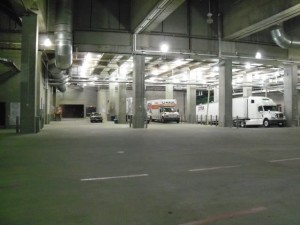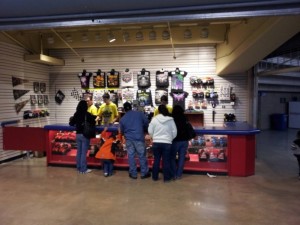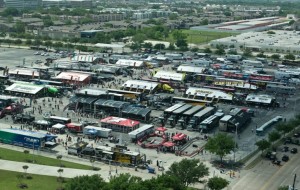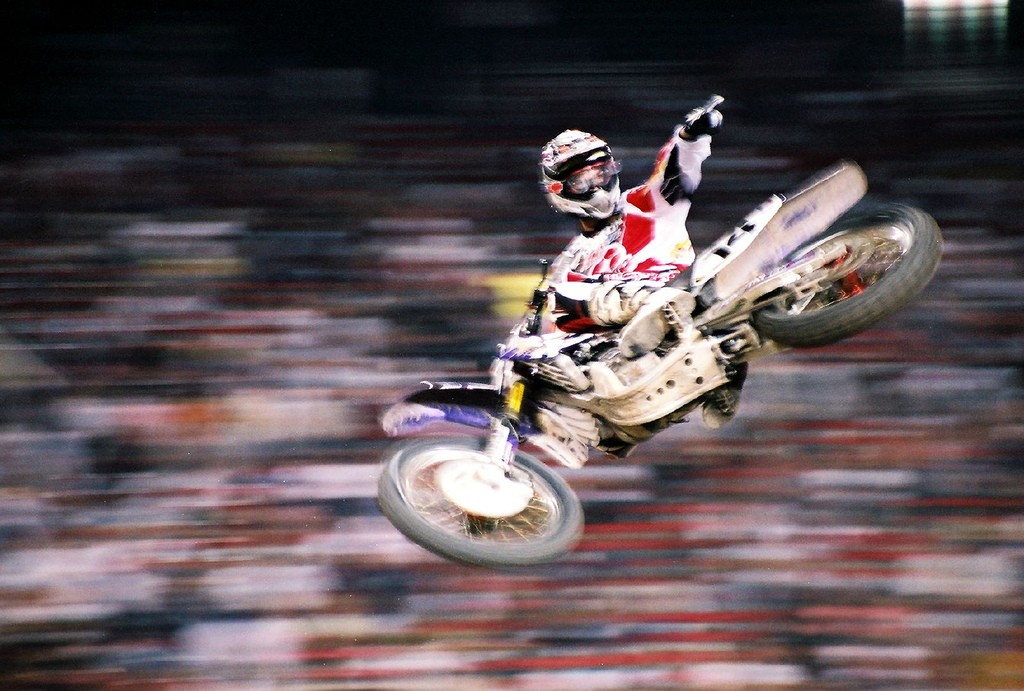There are a few new stadium projects in the works with even more stadiums planning upgrades to their existing facilities. These projects are extremely costly, so withstanding the test of time, being relevant for next 30-plus years should be goal No. 1 for any upgrade or new stadium venture. This article highlights certain best practices and ideal stadium designs that we, the promoter of stadium events, have found very helpful throughout our 20-plus years of producing stadium events.
Loading Docks
 When operation crews arrive on site time is always money, the quicker they can load-in and out the better, and it all starts with how the loading dock is setup. Ideally, a stadium loading dock will have a large secure indoor area able to accommodate up to 10 semi-trailers and is adjacent to the main field tunnel. Adjustable docks that can be raised and lowered are also a plus, as they help speed up the delivery process. Operations crews also prefer a large secure staging area that can accommodate up to 60 semi-trailers. In addition to the trailers, this staging area would store heavy construction equipment such as bulldozers and skid steers. The main tunnel to the venue floor would be ideally located at the center of each end zone, and the entrance should be a minimum of 20-feet wide and at least 15-feet high. In addition, four additional smaller tunnels 15-feet wide by 15-feet high at all four corners of the stadium floor are recommended. The tunnel ramps to the venue floor should have no grade (or a gradual) to allow trailer access onto the field. Also offsetting the field tunnels to the tunnels leading outside is a good idea, as it will cut down on the draft coming onto the floor when both tunnel doors are open.
When operation crews arrive on site time is always money, the quicker they can load-in and out the better, and it all starts with how the loading dock is setup. Ideally, a stadium loading dock will have a large secure indoor area able to accommodate up to 10 semi-trailers and is adjacent to the main field tunnel. Adjustable docks that can be raised and lowered are also a plus, as they help speed up the delivery process. Operations crews also prefer a large secure staging area that can accommodate up to 60 semi-trailers. In addition to the trailers, this staging area would store heavy construction equipment such as bulldozers and skid steers. The main tunnel to the venue floor would be ideally located at the center of each end zone, and the entrance should be a minimum of 20-feet wide and at least 15-feet high. In addition, four additional smaller tunnels 15-feet wide by 15-feet high at all four corners of the stadium floor are recommended. The tunnel ramps to the venue floor should have no grade (or a gradual) to allow trailer access onto the field. Also offsetting the field tunnels to the tunnels leading outside is a good idea, as it will cut down on the draft coming onto the floor when both tunnel doors are open.
Performance Area
The ideal size of the performance area for a stadium is 400-feet by 325-feet with a preferred rectangular shaped floor rather than tapered corners and wall height of at least eight feet all the way around. A concrete floor with removable field turf or grass is financially and operationally most ideal. Six fire hose connections close to the performance area located in the corners and at the 50-yard lines should cover any water needs. Also, most promoters require 110 and 220 volt power around the floor and in the main tunnel. All indoor stadiums should have an air EVAC system that can exchange all the air in the venue every 30 minutes, and in a perfect world would also have a ventilation system specific to the main tunnel area.
Production Offices
The locations of the production offices are very important to show promoters. Most are looking for a main production office located close to the field ramp or main tunnel entrance suitable for up to 30 people. It is also a plus to have three or four small meeting or dressing rooms attached to this main production office. Tile or vinyl floor is preferred over carpet in the main production office with double doors for easy load-in and out and adequate power outlets on all walls. Promoters and operations crews also prefer a storage area adjacent to the production office able to accommodate up to 25 road cases. A “green room” holding area for VIPs, performing groups, and such in close proximity to the main tunnel, along with a medical room for the back of house medics near the same area, are nice additions, too.
Merchandise Areas
 The locations available to vend merchandise are limited by the depth of the concourse. Concourse depth is an important consideration for vending merchandise all the way around the stadium. A wide concourse area will allow merchandise stands and sponsor displays to be easily accessed without impeding spectator flow. Ideally, the stadium will have eight main level, built-in merchandise stands located at the 20-yard lines and in corners, with each stand having access to power and Internet, not Wi-Fi as the signal is not dependable during show times. Our preferred minimum footprint for our merchandise stands is 30-feet wide by 20-feet deep with a minimum height of 20-feet. Storage within these built-in stands due to the large amount of merchandise items to be sold is strongly recommended. The selling time window is small and product replenishment is difficult, so any extra storage space within the stand itself is extremely beneficial. The upper deck area is generally the hardest level to vend merchandise, and it is usually because stadium upper decks have narrow concourses. Having the same amount of vending locations on the upper deck would be great but it is understood that this is not always possible. Suites and club level areas are getting larger so it is also ideal to have vending locations on these levels that are similar to other concourse levels. A large portion of the merchandising in stadiums is distributed from the service level. The preference for this is a large secure space that can be configured many different ways based on the show or the amount of product. Freight elevators in four locations around the stadium that service every concourse level located close to the loading docks is extremely helpful for our events due to the large volume of activities we have on the public concourse levels.
The locations available to vend merchandise are limited by the depth of the concourse. Concourse depth is an important consideration for vending merchandise all the way around the stadium. A wide concourse area will allow merchandise stands and sponsor displays to be easily accessed without impeding spectator flow. Ideally, the stadium will have eight main level, built-in merchandise stands located at the 20-yard lines and in corners, with each stand having access to power and Internet, not Wi-Fi as the signal is not dependable during show times. Our preferred minimum footprint for our merchandise stands is 30-feet wide by 20-feet deep with a minimum height of 20-feet. Storage within these built-in stands due to the large amount of merchandise items to be sold is strongly recommended. The selling time window is small and product replenishment is difficult, so any extra storage space within the stand itself is extremely beneficial. The upper deck area is generally the hardest level to vend merchandise, and it is usually because stadium upper decks have narrow concourses. Having the same amount of vending locations on the upper deck would be great but it is understood that this is not always possible. Suites and club level areas are getting larger so it is also ideal to have vending locations on these levels that are similar to other concourse levels. A large portion of the merchandising in stadiums is distributed from the service level. The preference for this is a large secure space that can be configured many different ways based on the show or the amount of product. Freight elevators in four locations around the stadium that service every concourse level located close to the loading docks is extremely helpful for our events due to the large volume of activities we have on the public concourse levels.
Video Production
Most all stadium events require video production. A state-of-the-art sound and video system with a main control room that is located on the club or suite level at the 50-yard line is ideal. This main control room would be a large room with several smaller rooms attached. These smaller rooms should have removable glass and room to accommodate up to five people with their computers. All stadium lights should operate on shutters for instant on and off, and there should be designated camera and spotlight platforms at the 50-yard lines (high and low), corners, and in the end zones. Remote frequency cameras should have a signal in all areas of the stadium including the tunnels and loading dock. Video monitors should be in abundance throughout the stadium including in each tunnel entrance on the service level. Ribbon LED boards have become very popular and should be around the entire stadium between the seating levels. Clear-comm communications should be available and reach all areas of the stadium including press box, operational booths, show’s control room, and TV truck pad.
Wi-Fi Access
All stadiums know they need to deliver additional applications and services that enhance the fan experience to fill as many seats as possible. Video replays and real-time statistics, along with in-seat food and beverage ordering, have become requirements for a complete fan experience. Promoters would love to have adequate bandwidth for the ever-increasing customer demand for connectivity. Once most stadiums hit around 10,000 fans, the connectivity is greatly reduced. The NFL has mandated better connectivity in all its stadiums, but we have found the improvements to this point are negligible.
Fan Fest Area
 Every stadium should have a large tailgate or fan fest area for pre-event activities. These areas are ideally located near the stadium’s main entrances and allow vendors easy access to power and the Internet. Venue ticket scanners should work in these remote areas. As an example, Monster Energy Supercross and Monster Jam Fan Fests give fans access to the riders and drivers and also allow sponsors to show off their newest products and fashions. Supercross and Monster Jam Fan Fests require around 450,000 square feet of space with adequate lighting and auxiliary power throughout. Supercross Fan Fests require an additional area that allows parking for up to 40 tractors and 20 motorhomes.
Every stadium should have a large tailgate or fan fest area for pre-event activities. These areas are ideally located near the stadium’s main entrances and allow vendors easy access to power and the Internet. Venue ticket scanners should work in these remote areas. As an example, Monster Energy Supercross and Monster Jam Fan Fests give fans access to the riders and drivers and also allow sponsors to show off their newest products and fashions. Supercross and Monster Jam Fan Fests require around 450,000 square feet of space with adequate lighting and auxiliary power throughout. Supercross Fan Fests require an additional area that allows parking for up to 40 tractors and 20 motorhomes.
Dirt and Dirt Storage
You’ve probably heard the reference to something as “dirt cheap,” and I’ve often wondered how this saying ever came about as it is far from being the truth. The reality is dirt is not cheap to purchase and maintain, and it’s even more expensive to move. Having an area on site or near a stadium where 6,500 yards of dirt can be stored year round with an easy access route to the stadium’s main tunnel is a major advantage for any stadium looking host events over dirt. There are many creative ways dirt can be stored on a stadium campus, from creating a 20-foot high sound wall or berm that could help reduce unwanted highway or other noises to spreading it out over a parking area, covering the dirt with a road base material to allow cars to park on top. There could also be potential storage areas near the stadium—industrial parks and highway overpasses make great locations for storing dirt. These areas could be in or around your stadium; odds are you are passing a great dirt storage location daily on your commute to work.
This article listed just a few items that have been found through the years to be among some of the best stadium design ideas from the eyes of the promoters. Hopefully these ideas can provide additional insight to anyone looking to design or rehab a new or existing stadium.
(Image: Pam Falcioni/Creative Commons)


Tony,
Great points for stadium design teams. Thanks for sharing your perspective as the customer coming into our facilities. It’s all about servicing the customer and it’s easy when you know their expectations.
Great tips, I would add that from a design point of view, architects must talk to people that work in the industry before they start designing a venue. The information they can give on how the flow of production, crowd and revenue works is priceless and will make the venue that much better in the end.